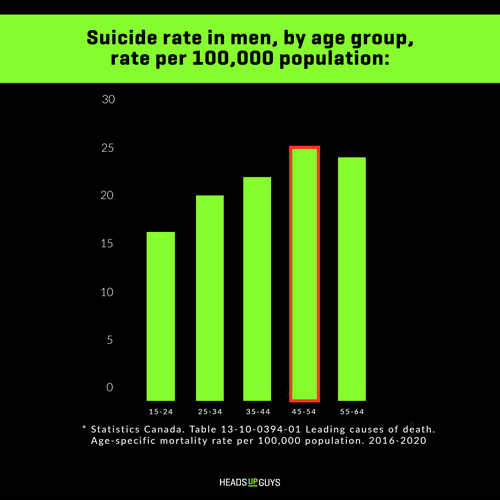
World Suicide Prevention Day 2022
On September 10th, we take a moment to remember the lives ended by suicide and raise awareness of how we can help prevent these deaths.

On September 10th, we take a moment to remember the lives ended by suicide and raise awareness of how we can help prevent these deaths.
"Support our Midnight Watch Campaign"
World Suicide Prevention Day (WSPD) is recognized every September 10th by over 60 countries around the world.
We wanted to share some statistics with you to better understand the serious toll suicide is taking on men (and the important people in their lives), and provide you with an opportunity to help us prevent it.
 The answer is age 45 – 54.[1] This fact surprises a lot of people. As men move into their 30’s, 40’s, and 50’s and life’s pressures mount, death by suicide increases. The devastation felt by those left behind is enormous.
The answer is age 45 – 54.[1] This fact surprises a lot of people. As men move into their 30’s, 40’s, and 50’s and life’s pressures mount, death by suicide increases. The devastation felt by those left behind is enormous.
Why is the rate of suicide higher for men ages 45 – 54?
There are plenty of factors that contribute to this statistic. Unfortunately, many guys don’t think about or discuss their health enough (especially mental health), but by their late 30’s to early 50’s, their lives may be packed with stressors that, when unaddressed, can lead to depression and suicidal thoughts.
Some of the factors that can weigh heavily on men in this age group are:
All of these factors and others contribute to the impact on men’s mental health.
Our research shows that men search for words related to suicide most often between 9:00 pm and 4:00 am.
Searching for terms such as “suicidal thoughts”, “I want to die”, and “kill myself”.
We want to try to interrupt this thinking through a new campaign idea and opportunity for matching donations.
Scene – nighttime, guy slouched on couch, phone in hand, TV playing in background]
Clint promised his partner he would be coming to bed in 15 minutes. “I just want to chill in front of the TV, have a quick beer, check the hockey scores, and I’ll be right there.”
90 minutes have passed, it’s now 12:35 am. Clint is on his third beer and has lit up a joint. Nighttime is the worst for Clint – he feels a sense of anxiety, fear, and hopelessness taking over again. The beer and the pot temporarily numb the immense weight of everything. He looks at his phone and types into the search bar “I want to die”.
This is the third night in a row he has searched about taking his life.
[end scene]
Clint’s story is not unique. Unfortunately, it is far too common.
We need to reach men before they reach the end of hope.
We are raising $10,000 to purchase commercial TV spots that will air between 9:00 pm and 4:00 am to let men know that help is out there.
This way, when guys are sitting alone at night, feeling hopeless, and thinking about ending it – we can interrupt their thinking with our HeadsUpGuys PSA. We can get them thinking there is a better way, directing them to our resource to help them on their journey to recovery.
We’re able to do this through a generous media partner offer, allowing us to double the reach of donations, with a buy 1, get 1 free deal.

References:
The banner image for this article was created by the HeadsUpGuys Team using Midjourney (an AI-powered image creator) with the prompt: “young men hold candles at vigil for friend, symmetrical, dramatic, peaceful, super detailed, super realistic, bright, hopeful by james jean”
Too many men suffer in silence. Become a peer supporter for the men in your life.
In this four-part course (15–20 min each), you’ll learn what effective peer support looks like, how to show up for others, and how to stay grounded while doing so.